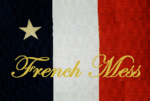Hi all,
I'm doing research on the Augusta jackets that were being issued late in the war. According to a Savannah quartermaster they were white wool jackets and "a poor article" of clothing. If anyone has any examples or other citations from other quartermasters or soldiers, could you point me in the right direction please?
Thanks in advance!
I'm doing research on the Augusta jackets that were being issued late in the war. According to a Savannah quartermaster they were white wool jackets and "a poor article" of clothing. If anyone has any examples or other citations from other quartermasters or soldiers, could you point me in the right direction please?
Thanks in advance!



Comment